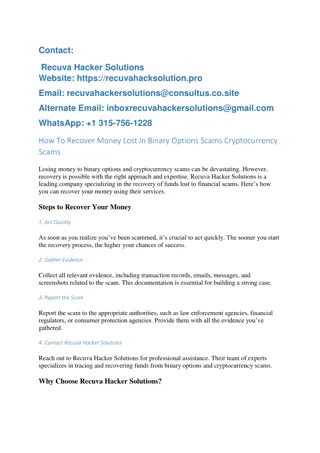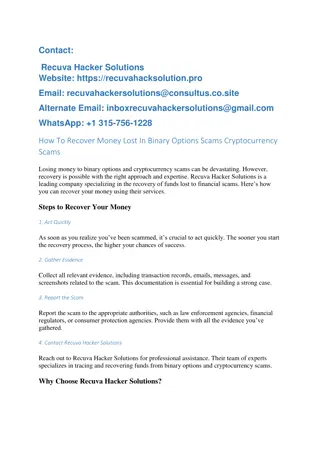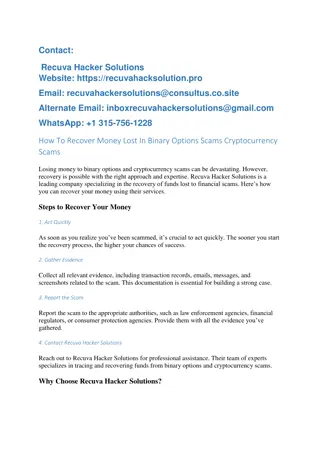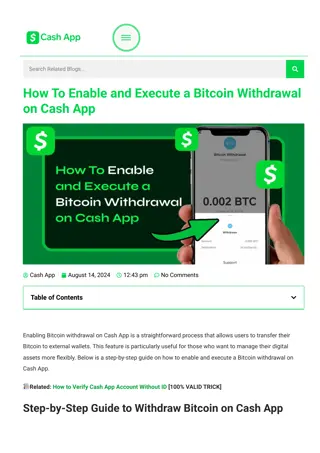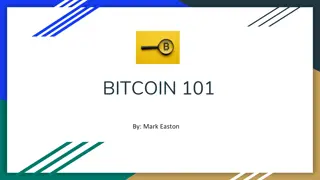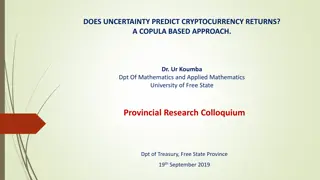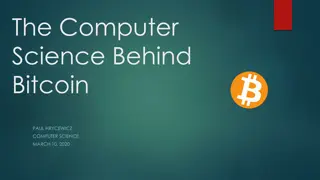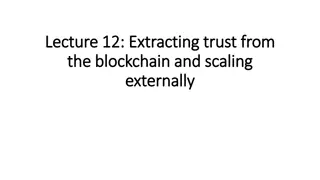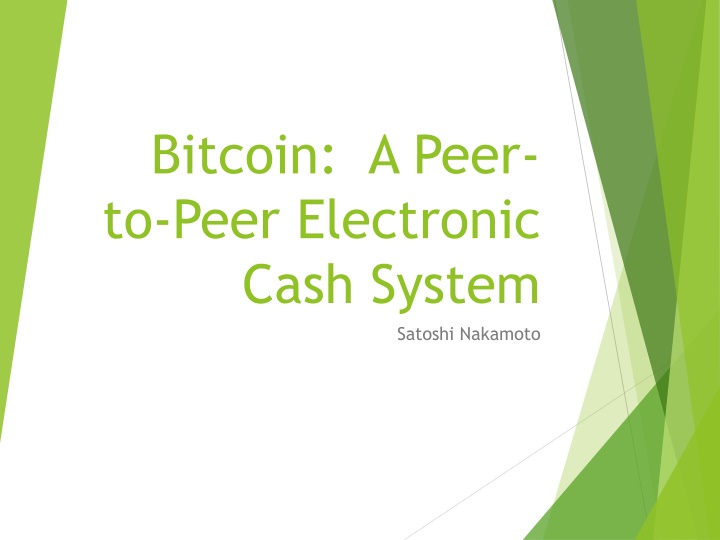
The Evolution of Bitcoin: A Peer-to-Peer Electronic Cash System
Explore the concept of Bitcoin as a decentralized digital currency created by Satoshi Nakamoto, revolutionizing the way transactions are conducted without the need for a trusted third party. Learn about its unique features, transaction process, and the motivation behind its development to address double-spending issues.
Download Presentation

Please find below an Image/Link to download the presentation.
The content on the website is provided AS IS for your information and personal use only. It may not be sold, licensed, or shared on other websites without obtaining consent from the author. If you encounter any issues during the download, it is possible that the publisher has removed the file from their server.
You are allowed to download the files provided on this website for personal or commercial use, subject to the condition that they are used lawfully. All files are the property of their respective owners.
The content on the website is provided AS IS for your information and personal use only. It may not be sold, licensed, or shared on other websites without obtaining consent from the author.
E N D
Presentation Transcript
Bitcoin: A Peer- to-Peer Electronic Cash System Satoshi Nakamoto
Bitcoin 19 out of 21 million bitcoins have been mined As of March 2018, it is trading at $9,000 per coin
Motivation Seller: renders a non-reversible service Buyer: pays a check The bank account may not have the money If the buyer writes two $100 checks with only $100 is in the account Alternatives: Physical cash Uses a credit card where the third-party bank holds the buyer accountable
Motivation Need a way to pay over a communication channel Without a trusted third party Need to rely on cryptographic proof instead of trust My claimed account balance can be independently verified Allow two parties to transact directly with each other Without the need of a trusted third party Bitcoin: a solution to double spending problem Using a distributed timestamp server to generate proof of the chronological order of transactions Assumptions: Honest nodes control more CPU power than attacking nodes
Transaction An electronic coin as a chain (cryptographic transfer history) of digital signatures
Transaction Each owner j transfer the coin to the next j+1 by digitally signing a hash Of the previous transaction and the public of key of j + 1 Transaction 1 Keypublic_j+1 hash PKE Owner j s signature Keyprivate_j
Transaction Each owner j transfer the coin to the next j+1 by digitally signing a hash Of the previous transaction and the public of key of j + 1 Transaction 1 Transaction 2 Keypublic_j+1 hash PKE Owner j s signature Keyprivate_j
Transaction (Coin = a Chain of Signatures) Each owner j transfer the coin to the next j+1 by digitally signing a hash Of the previous transaction and the public of key of j + 1 Transaction 1 Transaction 2 Transaction 3 Keypublic_j+1 Keypublic_j+2 hash hash PKE PKE Owner j s signature Owner j+1 s signature Keyprivate_j Keyprivate_j+1
Transaction D(Keypublic_j+1, transaction 3) = hash(transaction 2, Keypublic_j+2) Can verify owner j + 1 s signature using j + 1 s public key Can verify the entire chain of signatures Transaction 1 Transaction 2 Transaction 3 Keypublic_j+1 Keypublic_j+2 hash hash PKE PKE Owner j s signature Owner j+1 s signature Keyprivate_j Keyprivate_j+1
Problem with this Transaction Model Double spending One can verify that transaction 2 has a legitimate chain of signatures Another one can verify that transaction 2 also has a legitimate chain of signatures Transaction 1 Transaction 2 Keyprivate_j Transaction 2
One Solution Use a trusted central authority mint After each transaction Coin must be returned to the mint to issue a new coin Only coins issued from the mint are trusted Drawback Every transaction needs to go through the mint
Arriving Another Solution If someone signs the same transaction (history) twice Only the first signature counts To be able to detect the second signature Global knowledge is required Mint s centralized model relies on global knowledge Without a trusted party Transactions must be publically announced All participants need to agree on a single history of the order in which the announcement was received The payee needs proof that at the time of transaction Majority of nodes agreed he received the first signature
Timestamp Server Take a hash of a block of items to be timestamped and publish the hash E.g., in a newspaper or Usenet post Timestamp proves that the data must have existed at the time to get into the hash Each timestamp includes the previous timestamp in its hash, forming a chain Hash Hash Block of items Block of items
Proof of Work If effort to generate the timestamp hash chain is low, someone with the CPU cycles to rewrite the history Need proof of work to make this process expensive
Proof of Work hash(previous hash, transactions, nonce) < threshold Where nonce is a random guess Smaller the threshold, exponentially increasingly computational effort is needed to generate this legitimate hash A block cannot be changed without redoing the work of guessing the nonce And the nonce for the subsequent blocks Block Previous hash Block Previous hash Hash Txs nonce Txs nonce
Proof of Work The majority decision is based on the longest block chain or the greatest proof of work effort invested Note Proof of work is not voted by the number of IP addressed But by the number of CPU cycles If most CPU cycles are controlled by honest nodes, the honest chain will grow faster than competing chains To modify the past, an attacker would have to redo the proof for all blocks
Proof of Work As hardware speed increases overtime The threshold for proof of work reduces Difficulty of guessing a correct nonce increases Targeting an average number of blocks generated per hour
Proof-of-Work Network Run the following steps New transactions are broadcast to all nodes Each node collects new transactions into a block Each node solves for the nonce for its block If the nonce is found, broadcasts the block to all nodes Nodes accept the block if all transactions in it are valid and not already spent Nodes accept the block by creating the next block in the chain, using the hash of the accepted block
Proof-of-Work Network Nodes always consider the longest chain If two chains are received, the tie will be broken with the next proof Nodes working on the shorter chain will switch to the longer chain Nodes can detect a missed block if the previous hash field mismatched
Incentive The first transaction in a block is a special transaction Starts a new coin owned by the creator the block Encourages nodes to support the proof-of-work network Compensates for electricity expended Done without centralized authority Alternative Use transaction fees Encourage nodes to stay honest CPU cycles are better spent generating new coins than rewriting the history
Reclaiming Disk Space Once a coin is buried under enough transactions, older transactions can be discarded to save disk space Transactions are stored in a Merkle tree Block nonce Previous hash Root hash hash23 hash01 hash3 hash0 hash1 hash2 Tx3 Tx0 Tx1 Tx2
Reclaiming Disk Space When pruning (e.g., Tx0 Tx2) Interior hashes do not need to be stored Block nonce Previous hash Root hash hash23 hash01 hash3 hash2 Tx3
Combining and Splitting Value Unwieldy to make a separate transaction for every cent Transactions contain multiple inputs and outputs Normally, one input when a larger amount is going to be spent on smaller amount Multiple inputs when smaller amounts are combined to be spent At most two outputs One for payment One returning the change
Privacy All transactions are announced publicly Need to keep public key anonymous Ideally a new key pair is used for each transaction Still a problem for multi-input transactions
Calculations Attackers are likely to change one of its own transactions to take back money recently spent For large transactions, wait for 5-6 blocks to be committed based on the transacted block Very difficult for an attacker to alter the history beyond this chain length

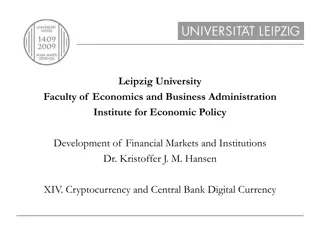

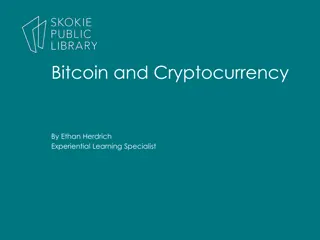
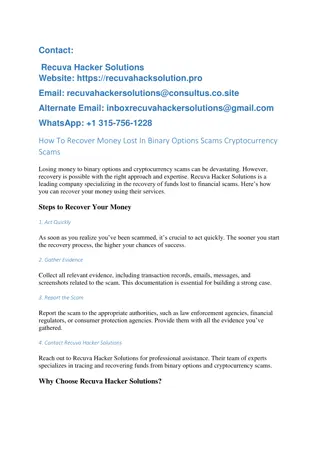

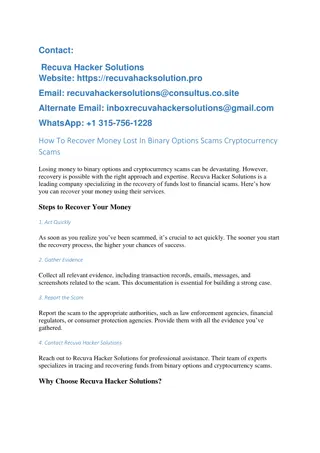

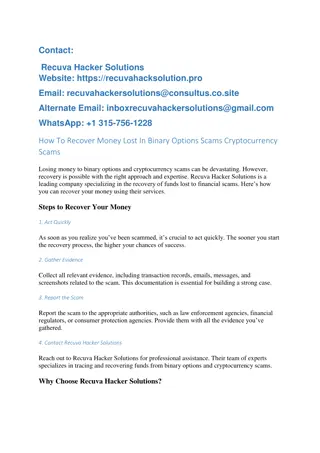
![101 Reviews How to Recover Lost Bitcoin [Scammed/Stolen Funds]](/thumb/153354/101-reviews-how-to-recover-lost-bitcoin-scammed-stolen-funds.jpg)
